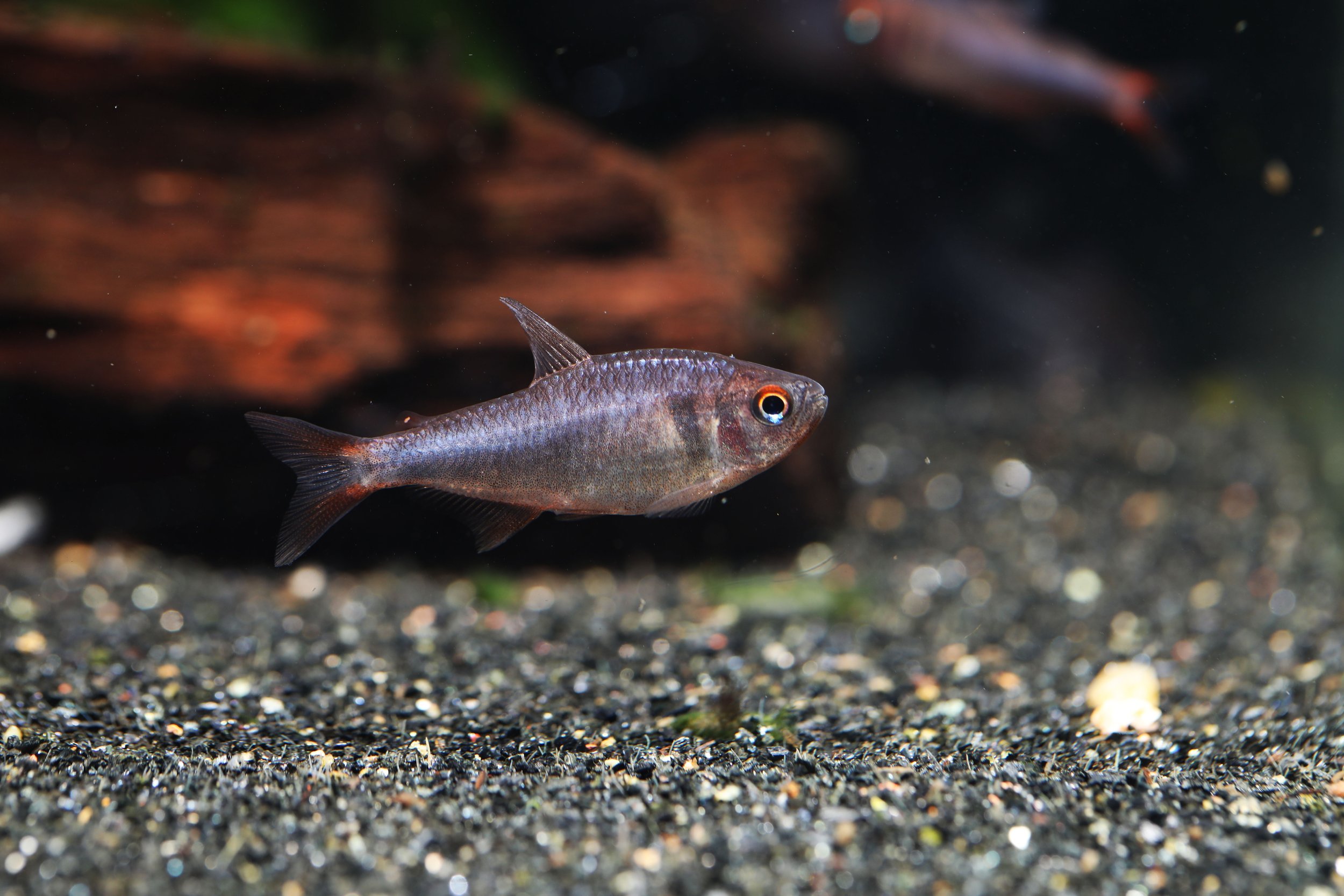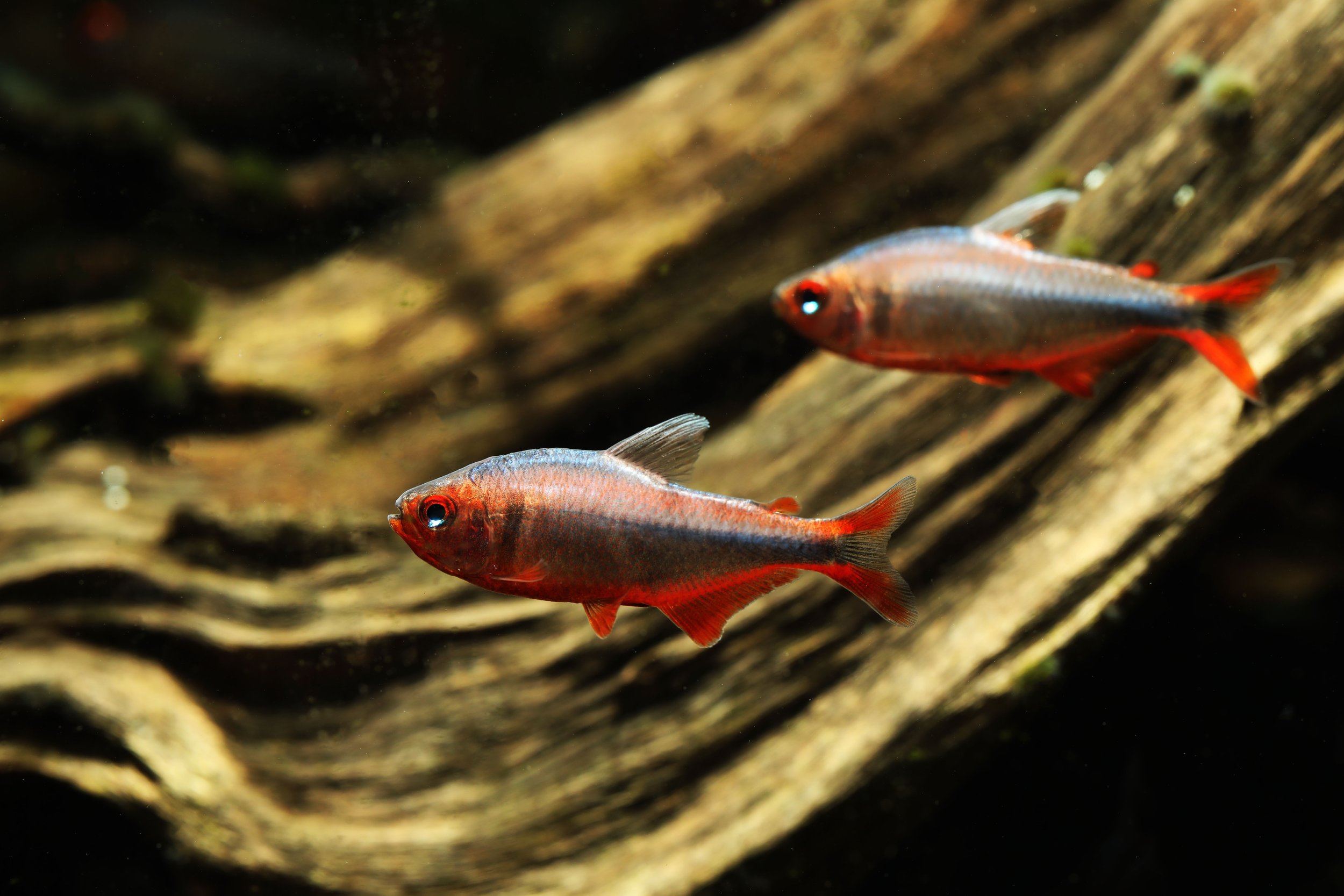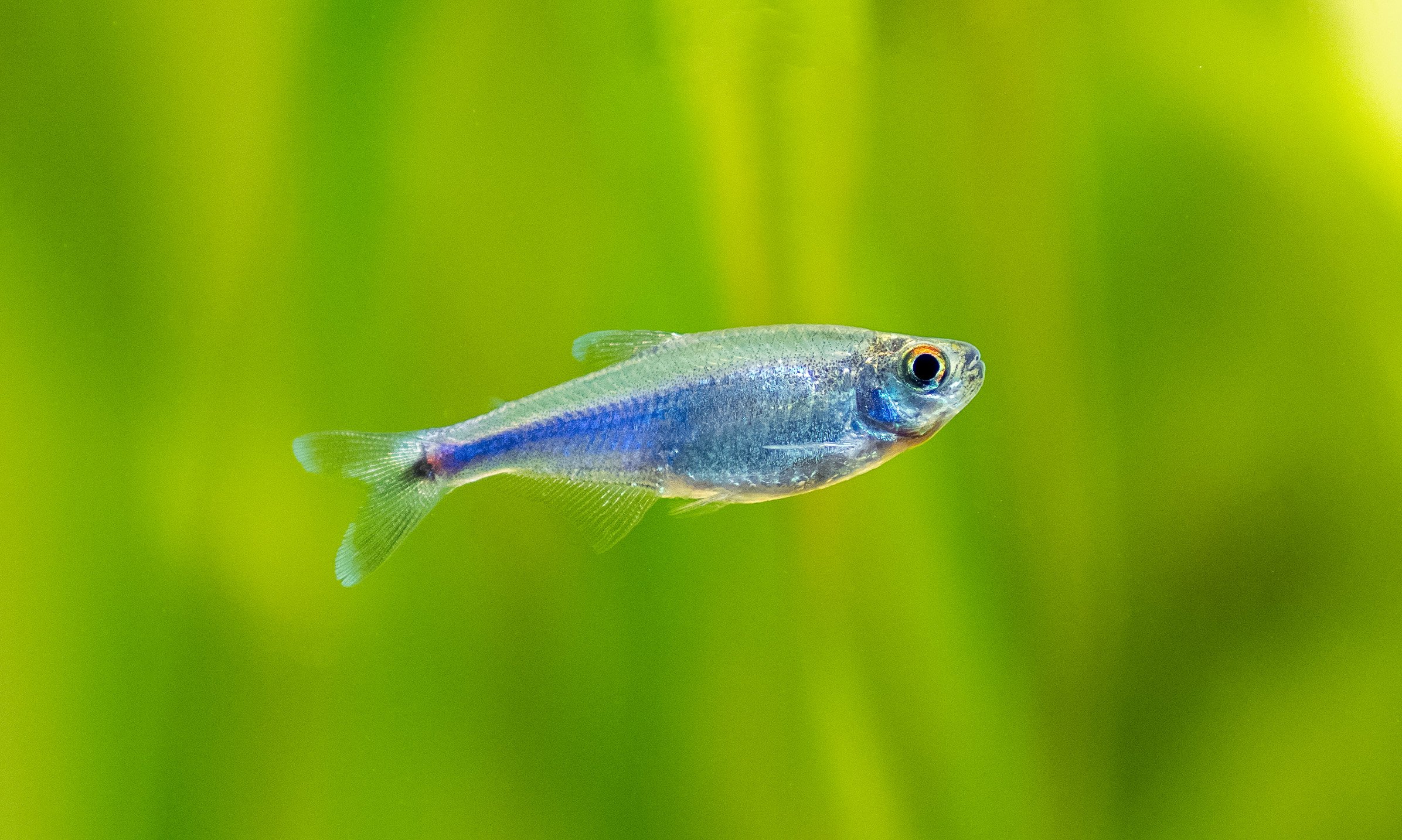 Image 1 of 3
Image 1 of 3

 Image 2 of 3
Image 2 of 3

 Image 3 of 3
Image 3 of 3




Blueberry Tetra
The Blueberry Tetra, scientifically known as Hyphessobrycon wadai, is a relatively new and rare addition to the aquarium hobby, cherished for its striking coloration and peaceful nature. Native to the clear waters of the Rio Paraguay basin in South America, this tetra has quickly gained popularity among aquarists for its unique and vibrant appearance.
Physically, the Blueberry Tetra is characterized by its striking iridescent blue body that shimmers under aquarium lighting, resembling the rich hues of a ripe blueberry. The body is slender and slightly elongated, with subtle red or pink accents on the fins and a slightly translucent tail. Mature specimens typically reach lengths of about 1.5 to 2 inches (3.8 to 5 centimeters), making them suitable for a variety of aquarium sizes.
In aquariums, Blueberry Tetras thrive in well-planted tanks with soft substrates and ample hiding spots. They prefer an environment with moderate water flow and subdued lighting to mimic their natural habitat. These tetras are peaceful and do well in community tanks with other non-aggressive species of similar size. It’s recommended to keep them in groups of at least six to eight individuals to encourage natural schooling behavior, which helps them feel secure and display their best colors.
Water parameters for Blueberry Tetras should closely mimic those of their natural environment. They prefer slightly acidic to neutral water with a pH range of 6.0 to 7.5 and temperatures between 72 to 80°F (22 to 27°C). Regular water changes and good filtration are essential to maintain the clean, stable water conditions that these tetras require.
Feeding Blueberry Tetras is straightforward, as they are omnivorous and will accept a variety of foods. They readily consume high-quality flakes, micro-pellets, and granules, as well as live or frozen foods such as daphnia, brine shrimp, and bloodworms. Providing a varied diet will help maintain their vibrant coloration and overall health.
Breeding Blueberry Tetras in captivity is possible, although it can be challenging due to their specific water requirements. To encourage breeding, provide a separate breeding tank with soft, slightly acidic water and fine-leaved plants or spawning mops for egg deposition. After spawning, the parents should be removed to prevent them from eating the eggs. The eggs typically hatch within 24 to 36 hours, and the fry can be fed infusoria or finely powdered fry food until they are large enough to consume baby brine shrimp.
Overall, the Blueberry Tetra (Hyphessobrycon wadai) is a captivating and valuable addition to freshwater aquariums, prized for its stunning blue coloration and peaceful temperament. With proper care and attention to their specific requirements, these beautiful tetras can thrive and bring a unique splash of color to aquarists of all levels of experience, enhancing the beauty and vibrancy of any aquatic environment.
The Blueberry Tetra, scientifically known as Hyphessobrycon wadai, is a relatively new and rare addition to the aquarium hobby, cherished for its striking coloration and peaceful nature. Native to the clear waters of the Rio Paraguay basin in South America, this tetra has quickly gained popularity among aquarists for its unique and vibrant appearance.
Physically, the Blueberry Tetra is characterized by its striking iridescent blue body that shimmers under aquarium lighting, resembling the rich hues of a ripe blueberry. The body is slender and slightly elongated, with subtle red or pink accents on the fins and a slightly translucent tail. Mature specimens typically reach lengths of about 1.5 to 2 inches (3.8 to 5 centimeters), making them suitable for a variety of aquarium sizes.
In aquariums, Blueberry Tetras thrive in well-planted tanks with soft substrates and ample hiding spots. They prefer an environment with moderate water flow and subdued lighting to mimic their natural habitat. These tetras are peaceful and do well in community tanks with other non-aggressive species of similar size. It’s recommended to keep them in groups of at least six to eight individuals to encourage natural schooling behavior, which helps them feel secure and display their best colors.
Water parameters for Blueberry Tetras should closely mimic those of their natural environment. They prefer slightly acidic to neutral water with a pH range of 6.0 to 7.5 and temperatures between 72 to 80°F (22 to 27°C). Regular water changes and good filtration are essential to maintain the clean, stable water conditions that these tetras require.
Feeding Blueberry Tetras is straightforward, as they are omnivorous and will accept a variety of foods. They readily consume high-quality flakes, micro-pellets, and granules, as well as live or frozen foods such as daphnia, brine shrimp, and bloodworms. Providing a varied diet will help maintain their vibrant coloration and overall health.
Breeding Blueberry Tetras in captivity is possible, although it can be challenging due to their specific water requirements. To encourage breeding, provide a separate breeding tank with soft, slightly acidic water and fine-leaved plants or spawning mops for egg deposition. After spawning, the parents should be removed to prevent them from eating the eggs. The eggs typically hatch within 24 to 36 hours, and the fry can be fed infusoria or finely powdered fry food until they are large enough to consume baby brine shrimp.
Overall, the Blueberry Tetra (Hyphessobrycon wadai) is a captivating and valuable addition to freshwater aquariums, prized for its stunning blue coloration and peaceful temperament. With proper care and attention to their specific requirements, these beautiful tetras can thrive and bring a unique splash of color to aquarists of all levels of experience, enhancing the beauty and vibrancy of any aquatic environment.
The Blueberry Tetra, scientifically known as Hyphessobrycon wadai, is a relatively new and rare addition to the aquarium hobby, cherished for its striking coloration and peaceful nature. Native to the clear waters of the Rio Paraguay basin in South America, this tetra has quickly gained popularity among aquarists for its unique and vibrant appearance.
Physically, the Blueberry Tetra is characterized by its striking iridescent blue body that shimmers under aquarium lighting, resembling the rich hues of a ripe blueberry. The body is slender and slightly elongated, with subtle red or pink accents on the fins and a slightly translucent tail. Mature specimens typically reach lengths of about 1.5 to 2 inches (3.8 to 5 centimeters), making them suitable for a variety of aquarium sizes.
In aquariums, Blueberry Tetras thrive in well-planted tanks with soft substrates and ample hiding spots. They prefer an environment with moderate water flow and subdued lighting to mimic their natural habitat. These tetras are peaceful and do well in community tanks with other non-aggressive species of similar size. It’s recommended to keep them in groups of at least six to eight individuals to encourage natural schooling behavior, which helps them feel secure and display their best colors.
Water parameters for Blueberry Tetras should closely mimic those of their natural environment. They prefer slightly acidic to neutral water with a pH range of 6.0 to 7.5 and temperatures between 72 to 80°F (22 to 27°C). Regular water changes and good filtration are essential to maintain the clean, stable water conditions that these tetras require.
Feeding Blueberry Tetras is straightforward, as they are omnivorous and will accept a variety of foods. They readily consume high-quality flakes, micro-pellets, and granules, as well as live or frozen foods such as daphnia, brine shrimp, and bloodworms. Providing a varied diet will help maintain their vibrant coloration and overall health.
Breeding Blueberry Tetras in captivity is possible, although it can be challenging due to their specific water requirements. To encourage breeding, provide a separate breeding tank with soft, slightly acidic water and fine-leaved plants or spawning mops for egg deposition. After spawning, the parents should be removed to prevent them from eating the eggs. The eggs typically hatch within 24 to 36 hours, and the fry can be fed infusoria or finely powdered fry food until they are large enough to consume baby brine shrimp.
Overall, the Blueberry Tetra (Hyphessobrycon wadai) is a captivating and valuable addition to freshwater aquariums, prized for its stunning blue coloration and peaceful temperament. With proper care and attention to their specific requirements, these beautiful tetras can thrive and bring a unique splash of color to aquarists of all levels of experience, enhancing the beauty and vibrancy of any aquatic environment.






